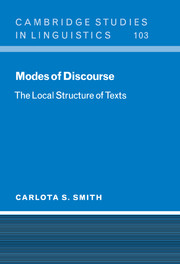Book contents
- Frontmatter
- Contents
- Preface
- Introduction
- PART I DISCOURSE STRUCTURE
- 1 The study of discourse
- 2 Introduction to the Discourse Modes
- 3 Text representation and understanding
- PART II LINGUISTIC ANALYSIS OF THE DISCOURSE MODES
- PART III SURFACE PRESENTATIONAL FACTORS
- PART IV DISCOURSE MODES AND THEIR CONTEXT
- Appendix A The Texts
- Appendix B Glossary
- References
- General index
- Index of names
2 - Introduction to the Discourse Modes
Published online by Cambridge University Press: 18 June 2010
- Frontmatter
- Contents
- Preface
- Introduction
- PART I DISCOURSE STRUCTURE
- 1 The study of discourse
- 2 Introduction to the Discourse Modes
- 3 Text representation and understanding
- PART II LINGUISTIC ANALYSIS OF THE DISCOURSE MODES
- PART III SURFACE PRESENTATIONAL FACTORS
- PART IV DISCOURSE MODES AND THEIR CONTEXT
- Appendix A The Texts
- Appendix B Glossary
- References
- General index
- Index of names
Summary
People intuitively recognize passages of the Discourse Modes, although they are probably unaware of the linguistic basis for the differences between them. Each mode – Narrative, Description, Report, Information, Argument – introduces certain entities into the universe of discourse, with a related principle of discourse progression. The features have linguistic correlates of a temporal nature. In fact temporality in the larger sense is the key to the discourse modes. Temporal factors are woven into the fabric of a language and are part of our tacit knowledge of language structure.
I use the term “passage” for text segments that realize a discourse mode. Passages must be long enough to establish the linguistic features that determine a mode. Two sentences suffice to do this. Intuitions are particularly strong when there is a shift of mode. As an example, consider (1), the beginning of an article from the National Geographic. The discourse mode shifts twice: from Information to Narrative and back to Information. The title and paragraphing follow the original.
(1) Listening to Humpbacks
1 When a big whale dives, currents set in motion by the passage of so many tons of flesh come eddying back up in a column that smooths the restless surface of the sea. 2 Naturalists call this lingering spool of glassy water the whale's footprint. 3 Out between the Hawaiian islands of Maui and Lanai, Jim Darling nosed his small boat into a fresh swirl. 4 The whale that had left it was visible 40 feet below, suspended head down in pure blueness with its 15-foot-long arms, or flippers, flared out to either side like wings.[…]
- Type
- Chapter
- Information
- Modes of DiscourseThe Local Structure of Texts, pp. 22 - 48Publisher: Cambridge University PressPrint publication year: 2003



